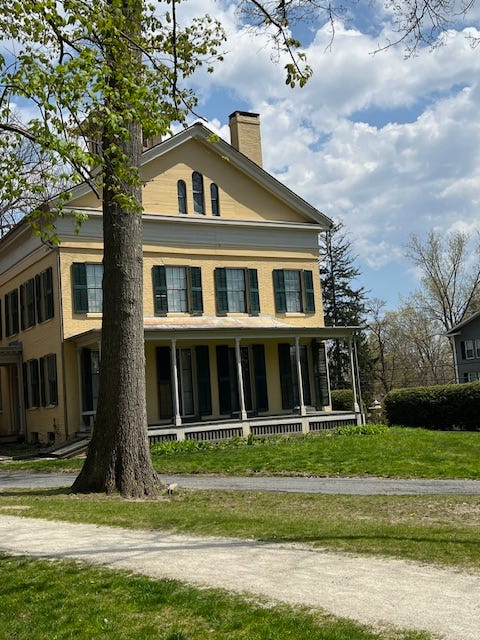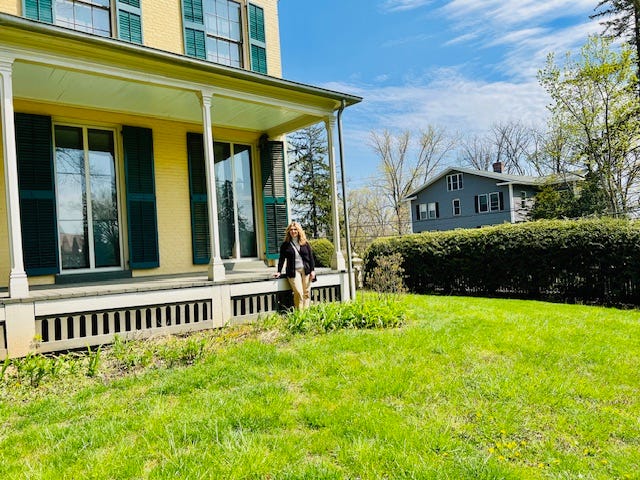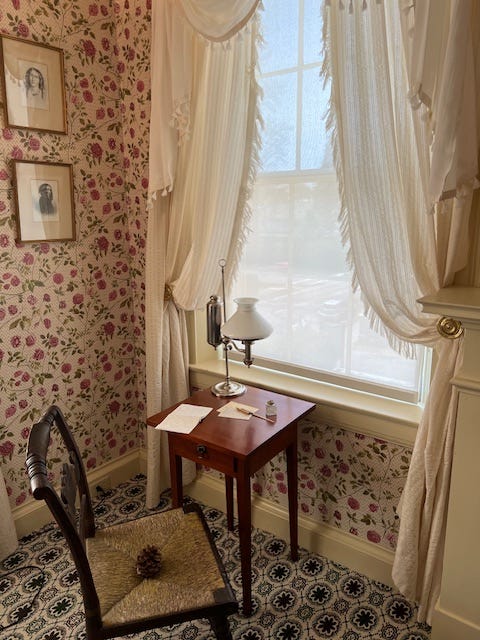Photo Courtesy of my iPhone- public mural in Amherst, MA
It’s National Poetry Month, and what better way to celebrate than by highlighting this month’s Rebel Writer: Emily Dickinson.
Born December 10, 1830 in Amherst, Massachusetts, Emily Dickinson is an American Lyric poet. Along with Walt Whitman, she is widely recognized as one 19th century’s greatest poets.
According to FamilySearch.Org, Emily is my 7th cousin, 4x removed, as my 10th great grandfather, Richard Belden Senior, is also Dickinson’s 7th great grandfather. Fun Fact: It was also recently discovered that Emily is a long-lost relative of Taylor Swift, as they are 6th cousins, 3x removed.
I visited the Emily Dickinson Museum in Amherst, Massachusetts last spring during my first tour of legendary writer’s homes. While Emily is not featured in Rebel Writers Volume I, she will be featured in Volume II, coming out later this year, along with Emerson, Thoreau, Wharton, and more.
Here’s a sneak peek at some of the amazing things I learned about Emily during my visit.
1. During Emily’s lifetime, only ten of her poems were published, all of which were not under her name and not with her permission. Emily wrote nearly 1800 poems in her lifetime and is known for her disregard of the rules of versification and grammar.
2. Frail as a child, Emily often missed school (much like H. P. Lovecraft and Gertrude Chandler Warner, who also battled illnesses young). In school, her teachers recognized her abilities in composition, Latin, and science. She was also a botanist at heart, assembling her own herbarium and often creating pressed flowers. She also enjoyed gardening.
3. Emily began composing poetry in her late teens. Very few of her early works are still in existence. In 1858, she began to assemble manuscript books by gathering copies of poems on fine stationary and sewing small bundles of them together. In fact, for a period of at least seven years, she created forty booklets with around 800 poems, which were not discovered until after her death. Researchers estimate that in the last years of her life; she wrote about 35 poems a year.
4. Some scholars say it is unclear if Emily meant to only give her poems to friends, keep them private, or publish. Emily did, however, contact critic Thomas Wentworth Higginson about possible publication. She had read an inspirational message he’d penned to writers in the Atlantic Monthly, which inspired her to send him her poetry. While he praised her writing, he warned her against publishing for the time being, claiming no one would understand her genius. Emily listened and did not publish. She continued to correspond with Higginson until her death and upon her death; he co-edited her work for publication. Emily also sent four poems to Thomas Nile, who edited Alcott’s Little Women, however, she mostly stuck to sharing her poems with family and friends for most of her life.
5. Emily faced many struggles, including vision issues during her thirties, agoraphobia, extreme anxiety, and a fear of death. Her fear of death began at a young age, stemming from deaths of her family and friends. Because of these struggles, Emily began restricting her social activity in her early twenties. Her seclusion created town gossip, as she garnered a reputation for being peculiar due to her isolation. She also seemed to have an obsession with wearing the color white, in a time where most dressed in darker, black clothes.
6. Emily experienced other hardships as well. Between the years of 1855-1859, her mother suffered from a mysterious illness, leaving Emily and her sister to complete all domestic pursuits within the household. These were tough years for Emily as also during this time, there was a bitter family lawsuit on her mother’s side of the family and financial issues when her father’s attempts to bring a railroad into town failed. These stressors further affected Emily, pushing her into withdrawal.
7. Emily did remain close to her brother and sister. As a child, she was especially close to her brother, Austin. She often wrote letters to him when he was away from home, discussing their shared interests in nature, local affairs, and other matters. When Austin became an adult and settled next door into his home, which was named ‘The Evergreens’, their relationship changed because he had less time for Emily. Once, when Austin stayed with Emily and their family while his wife and children were out of town, Emily noted,
“It seemed peculiar—pathetic—and Antediluvian. We missed him while he was with us and missed him when he was gone.”
It is important to note that Austin cared for his sisters, especially after the death of their parents. He was also with Emily when she died.
Regarding her sister Lavinia, Emily once wrote,
“She has no parents but me, and I have no parents but her.” (Letter 391).
It was her sister Lavinia that discovered Emily’s collection of almost 1800 poems after Emily’s death.
There is also much ado about Emily’s love life, and the dramas behind the editing and releasing of her poetry after her death. Want the full scoop? You’ll have to wait for Rebel Writers Volume II to get it!
In the meantime, here are some pictures I took with my iPhone of Emily’s bedroom, workspace, living room and more.
What can we learn from Emily’s life?
Just like Rebel Writers Volume 1, Volume II will be packed with lessons we can learn from writer’s lives. Emily’s life is full of lessons, from the importance of being authentic, finding value in small moments, and creating for the sake of creation.
For me, the biggest takeaway was the importance of standing by your art and making your own decisions, something Emily arguably was not good at.
It pained me to hear that Emily abandoned her publication aspirations after Higginson’s warning not to publish. I also find it distasteful that he didn’t seem to mind her poems being published after her death, upon his editing. The world was suddenly ready for her poetry, according to Higginson, after her death? I’m not a scholar, so perhaps there are other thoughts and explanations for his sudden interest in publishing her poetry. But for me, as a writer myself, I can’t help but wonder how things may have been different if Emily had been alive today. With so many paths to publication now available to a writer, would she have pursued them? Would she have had a Substack, for instance? I’d definitely subscribe to that!
At the very least, if she had not listened to Higginson, and published anyway, she would have at least seen her own work in print, hopefully on her terms. Even if she didn’t become the Emily Dickinson we know today, it would only have been a matter of time until her work reached the status it is today. At least then, she would have grown after sharing her work with the world, seeing it in print. And we would have had her true vision, not some edited version thereof.
Remember, creating art is not about just keeping it to yourself, though, that’s fine if that is what you choose to do with it. The truth of the matter is, art truly comes alive when shared with others. It’s then that it’s given wings to fly.
So, don’t be like Emily. If one person says no, keep knocking down doors. Trust yourself, not the motivations, jealousies, or ill advice you may receive from others.
Till Next Time,
Sarah
AKA A Busy Lady
© 2025 WHATS GOIN ON?! SLN Publishing LLC, ALL RIGHTS RESERVED
A Busy Lady is written by an actual human—no AI, just chocolate, creativity, and a love for storytelling. This also means there may be an occasional typo, just to prove a human did it ;)














